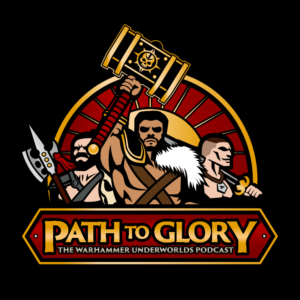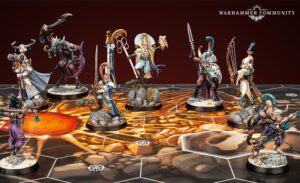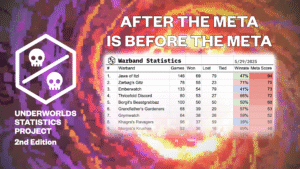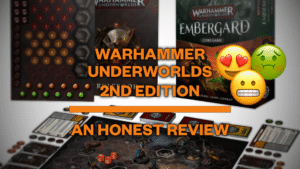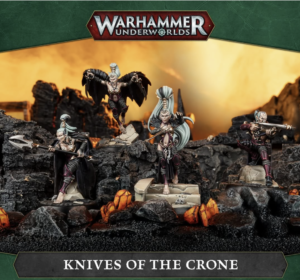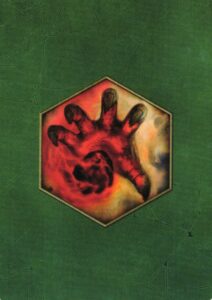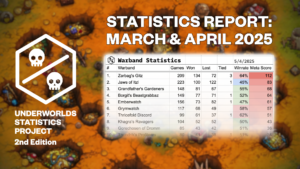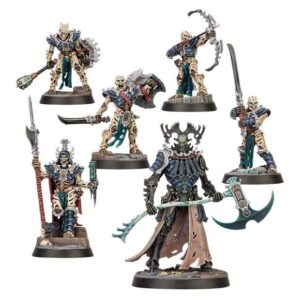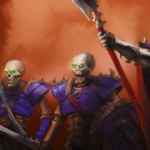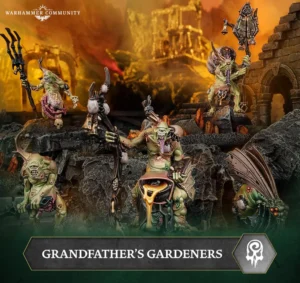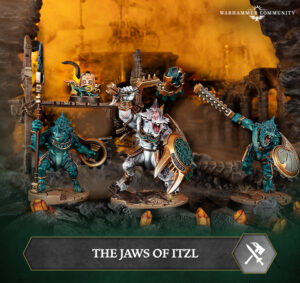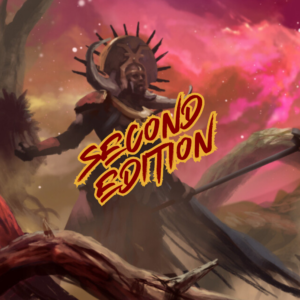Intro
Welcome to Embergard and the definitive second edition of Warhammer Underworlds! As you might’ve heard on our audio content leading up to this release, we are quite excited here in the PtG “studio” for the upcoming release and the hope that we see our community continue to grow with this new edition of the game. Games Workshop has stated themselves that a major design goal for the new edition was to create a more accessible game for new players, which of course means we have seen some streamlining in the game (for better or worse). To that end, a brief open letter before we get started:
If you’ve participated in various online conversations, you’ll probably already be familiar with my stances on the various updates, but I’d like to preface the discussion by saying that, despite my misgivings on particular changes, I am overall very optimistic for the future of Underworlds and I sincerely hope that all of you get a chance to try out the new edition. I understand that some folks are disappointed with the changes and have elected not to make the jump to the new edition. While that is absolutely your prerogative, I would encourage you to at least play the game before you write it off. If you make an earnest effort and you still feel it no longer holds up compared to the original, then I think you, as veteran players, are uniquely suited to provide the design team with constructive feedback about where you feel the new edition falls short and the game would ultimately end up the better for it. While I am personally making the jump to the new edition, I also want to speak out about some responses I have seen to those who prefer to stick with the first edition. While I am by no means saying this is the norm, I have seen a lot of comments towards these folks along the lines of “well if you don’t like the new game you don’t have to play it.” While that is 100% true, it is also 100% not constructive. Those of us who are excited for the new edition should want everyone to be excited for it, but that means meeting people where they are and trying to understand their point of view. Being excited for the new edition and being able to accept criticism of it are not mutually exclusive and, in fact, should not be. Therefore, while I am, of course, very grateful to GW for providing us a free copy of the game to review for you all, I can assure you that I will continue to do my best to accurately summarize information for you all while still conveying my authentic feelings (positive or negative) as that information is presented.
Alright, rant over, let’s jump into the changes, there are a lot of them! Note that I will not be doing a full summary of the rulebook, just highlighting things which have changed from the first edition. I’ve broken these changes down into what I consider “minor” and “major.” I’ve likely not touched on absolutely everything, but hopefully it’s enough to cover what you need to know if you’re familiar with the first edition.
Minor Changes
New Terminology
The smallest of small potato changes, but a here’s a list of new/modified terms to know which will be helpful when looking through the rest of our review content (I will delve into some of them more later). These are just quick summaries, but for the exact text, of course consult the rulebook.
- Treasure tokens – same as first edition objective tokens
- Stagger hexes – same as first edition snare hexes
- Hammer – same as first edition Smash (but now as it should be!)
- Swords – same as first edition Fury (but now as it should be!)
- Flanked – same as first edition single support
- Surrounded – same as first edition double support
- Save – same as first edition Defence
- Health – same as first edition Wounds characteristic
- Damage tokens – same as first edition Wound tokens
- Damaged – a fighter with one or more Damage tokens
- Undamaged – a fighter with no Damage tokens
- Melee weapons – weapons with Range characteristics of 1 and 2
- Ranged weapons – weapons with Range characteristics of 3+
- Runemarks – symbols associated with rules or abilities
- Brutal – rolls of Flanked or Surrounded do not count as successes in opponent’s Save roll
- Grievous – +1 Damage to the attack (notably not just on crits anymore)
- Grapple – if a target can be driven back, they can be pushed 1 hex instead
- Slain – same as first edition out of action/taken out of action
- Action Step – same as first edition activation step
- Combat Phase – same as first edition action phase
- Core Abilities – basically the same first addition “(super)actions” (more on these later)
- Surge abilities – same as first edition reactions
- Underdog – the player with the fewest glory points
- Any – synonymous with “one or more”
Card Art
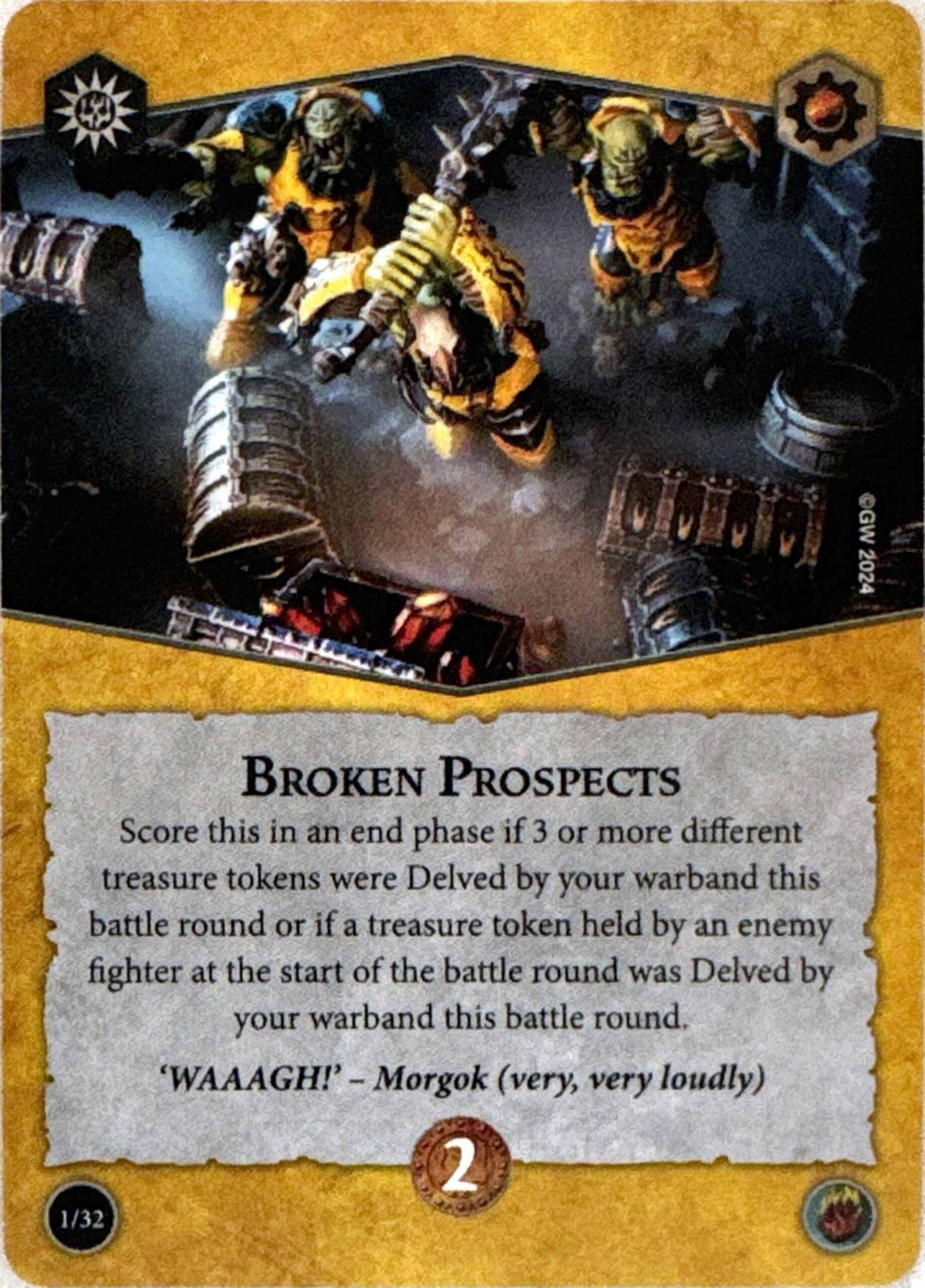
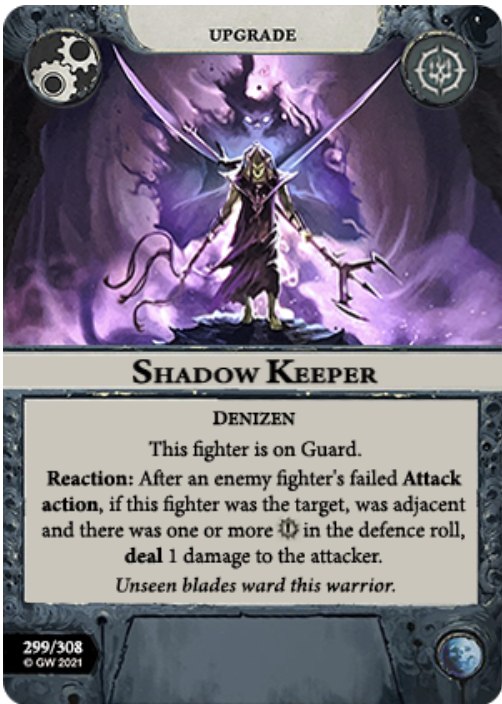
While it has absolutely no bearing on the gameplay, I felt it was only right that I take a few lines to lament the swap from the first edition card artwork to the miniature photographs. This is absolutely not meant as a slight to the photography team that I’m sure worked very hard on these, but as praise for the artists who have previously done some fantastic work in the first edition. I also feel obligated to state that GW (and I understand they are just trying to market the game) have gone way over the top in patting themselves on the back for this change. It’s just felt a bit disingenuous to me for what, to my outsider’s perspective, appears to be a cost-saving measure and I think it would have been far less inflammatory in the larger community if they hadn’t spent so much time talking about the shift. By no means do I think this will have a significant impact on my long-term enjoyment of Underworlds but, that doesn’t preclude me from being dissatisfied with the change.
Heal

Heal no longer has the “Heal(X)” construction, the term now just means that you remove one damage token from the fighter when you heal them. Notably, this doesn’t mean that we’ve seen the last of multi-heal cards (see the new version of Healing Potion), but just that things are a tad bit cleaner than they used to be here. The most significant rewording here is that when an undamaged fighter is healed, nothing happens. Unless I am reading this incorrectly, this is a quite a shift from when the rules stated that undamaged fighters “cannot” be healed, as it opens up the ability to resolve cards/abilities which have heal as one of their effects for undamaged fighters. I like this change a lot. While I still think they could have let “cannot” do a little more in terms of interrupting abilities mid-resolution, using fewer “cannots” will have a similar effect.
Delve
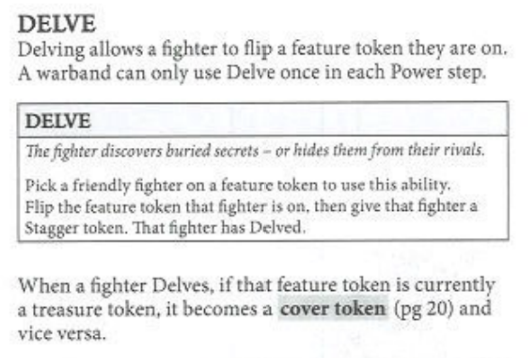
Delve is largely the same as it was in Wintermaw, but with the notable exception that you can now delve even when you already have a stagger token. This is another great change in terms of design space. It always felt so limiting to be unable to delve just because you were already staggered, especially in cases where you weren’t even staggered because of delving in the first place. More options are always good. Fortunately, you can still only delve once per power step, so the increase in its viability shouldn’t slow the game down nearly to the extent that we saw in the Ulgu seasons.
Guard and Stagger
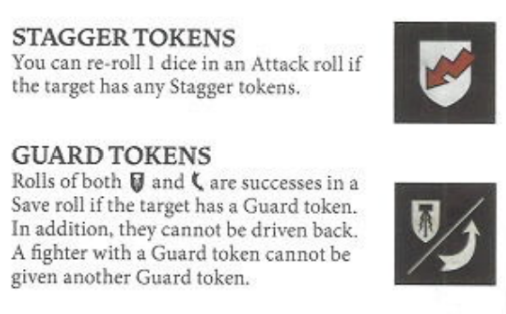
Guard and Stagger tokens no longer directly interact with each other (i.e. gaining one no longer removes the other). While we did have cases where a fighter could both be on guard and be staggered in the past, those were generally more niche than the application and/or flipping of the tokens. The end result of removing this interaction is that both mechanics get a nice little bump in value for me, as your opponent no longer has the ability to “counter” them barring other power card/ability support. Considering that both effect were often left in deckbuilding purgatory, I like seeing them brought a bit more to the forefront. For stagger, do make note that Stun and Barge no longer exist. I know, you’re all shocked and crushed, but I’m sure you’ll find a way to move forward…
End of Game Tiebreakers
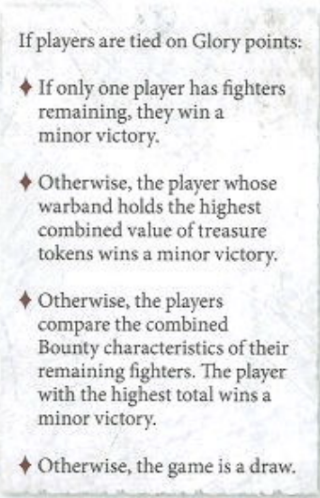
An extra tiebreaker was added at the end of the game. The sequence for determining a winner now goes: most glory points>warband annihilation>value of treasure tokens held>combined Bounty characteristics of remaining fighters. While hard ties are not something I have often encountered since the swap to value of tokens over simple number held, I certainly have no issue with making it even harder to tie, as ties are often dissatisfying for both players (as well as a headache for scoring at organized play events). While I would say that this tiebreaker will largely favor “Strike” playstyles since they will presumably be taking more of their opponent’s fighters (and therefore Bounty) off the table, it still is later in the sequence than holding tokens, so I’m fine with it. Overall, solid change, but not one that I expect to come into play often.
Roll-offs (Mechanics)
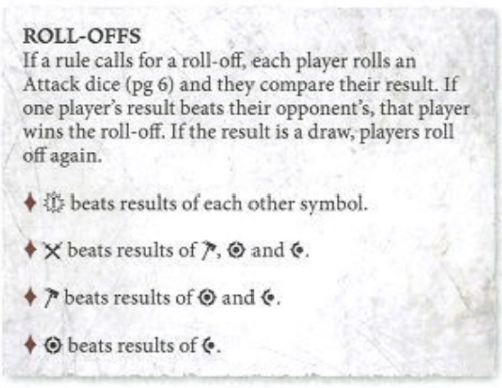
If I had made a section for “insignificant changes,” this probably would have made it in there, but roll-offs are now made with a single Attack die rather than rolling 4 dice. Furthermore, the hierarchy of results has changed as well, now going crit>sword>hammer>surrounded>flanked. This obviously has no strategic impact, but I’m sure I will be messing it up for a while. While this feels a bit like change for the sake of change to me, it’s a very neutral shift here, neither good nor bad really, although I will point out that this will naturally increase the frequency of ties. Speaking of which, from a tactical perspective, it is noteworthy that the Underdog wins ties on initiative roll-offs, which will obviously only be relevant in Round 2 and Round 3, but may add some strategic advantage to decks/strategies that come online in the later rounds, where we know the decision to go first or second is often quite critical.
Major Changes
Underdog
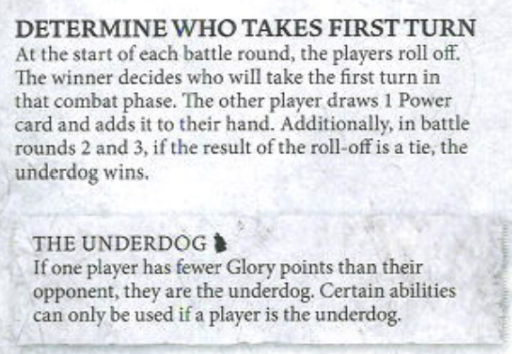
At any point in the game, the player with fewer glory points is labeled the Underdog. While the only thing this does on its own is break ties for initiative rolls, we’ve also seen that certain cards work differently, depending on whether or not you are the Underdog. For objectives, they appear to become (sometimes significantly) easier to accomplish, while power cards become (sometimes significantly) more powerful and/or more flexible. This will create a little minigame where you might try to intentionally fall behind a bit and then slingshot your way back into the lead off of some powerful Underdog effects. While I appreciate the attempt to make the game less punishing (particularly for newer players), I think this might be flattening the curve a bit too much in some instances. While it has opened up some opportunity for skill expression via the manipulation of the Underdog status (oddly kind of the opposite use of how the rule seems to be intended), it has removed some of that skill expression in the form of denial play. Just for example, the Pillage and Plunder Rivals deck has a surge objective called Claim the Prize which scores immediately after you delve in enemy territory. Knowing this card is in my opponent’s deck, I might attempt to deny them this glory by keeping them off objectives in my territory. However, if you are the Underdog, you can score that same card for delving in friendly territory as well, which makes the card basically unstoppable. While I’m sure we will see evolution over time in how this mechanic is implemented and its specific interactions with card effects, I think the most pressing thing that needs to be addressed is how easy it is to access. Heck, simply going second in the first round gives you pretty decent odds of becoming the Underdog immediately after your opponent’s first turn. I would personally have preferred this to only kick in at a certain glory threshold (maybe a difference of 5 or 10 or such) to minimize its impact on closely contested matches where neither player really feels like much of an “underdog.” I’d also like to see the power level of Underdog effects toned down going forward, as a number of those cards simply get too powerful too quickly. The impact of Underdog on the game outcome is the product of the ease of access and the reward for achieving that status, and right now I think the math on that is just not quite right for a competitive game. While I think this change should not be done away with entirely—it is interesting in principle, significantly expands the design space for modal cards, and I think the added niche of tiebreaking initiative rolls is a really nice way to mitigate the number of games rapidly descending into blowouts—I feel the execution of the mechanic as a whole is in need of a significant amount of fine tuning.
Upgrades
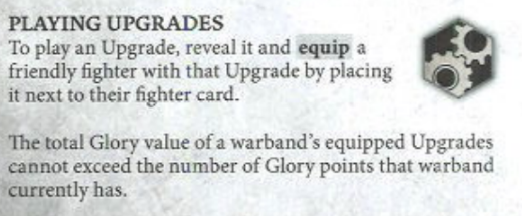
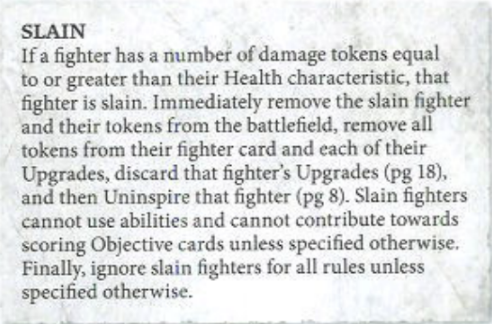
Upgrades have received a significant overhaul in a number of ways. The first is that they now vary in cost. Some cost 0, some 1, some 2 (and who knows, maybe we’ll see more expensive ones in the future). I like this particular change quite a bit, as it further opens the design space and can even the playing field a bit when some upgrades are clearly more powerful than others. However, looking at some of those present in the core set, I have to say that I feel like the values assigned are not always going to match the strength of the upgrades. Hopefully we see cost as a balancing lever they’re willing to pull on card errata, if it is needed.
Another change here which I’m not sure is for the better, you no longer spend glory to put upgrades down, you now can just have them equipped such that the value of your upgrades does not exceed the total number of glory you have. I have personally found this a lot harder to track now, but on its own this would not have merited landing in the “major changes” section. What’s landed it here is that, when a fighter is slain, you discard all of their upgrades and essentially get refunded the glory you spent on them to start beefing up another. I feel like this throws off the risk-reward we’ve seen on upgrades in the past. Where you once were able to balance the difficulty of killing an upgraded fighter with the reduction in potency of your opponent’s warband by removing said fighter, now they can just go and start stacking up another. At least they can’t give them back the exact same upgrades, but I’m still not a fan of the change. The silver lining here is that, for the most part, the cost of upgrades is often negligible in the later rounds of games anyway. Notably, this is also a significant nerf to warbands with raise mechanics, but we will see that balance out a bit with a significant buff shortly.
Bounty Restructuring

Well, if you want to put down upgrades, you’re still (generally) going to need some glory to do so, and kill Bounty remains a significant source of it. It seems as though the design target is for every warband to now yield 7 Bounty as an effort to impose more balance. While this is not so different for warbands that already yielded 7 (warbands like Reapers, Thorns, etc.), it is a significant increase for a number of elite warbands, with several jumping from 3 to 7. While you’d think this accounts for a nerf on those elite warbands, we have seen already a general increase in bulk as well in this edition which is going to make that elite fighter bounty harder to access than it once was. The warbands that really get punished here are those in the 5-fighter range, like we see with Zikkit’s Tunnelpack. They get stuck giving up more bounty with what appears to be minimal increase in bulk compared to what we might have seen prior. The general increase in Bounty that this imposes also generally favors more aggressive strategies, forcing even “Take and Hold” warbands to engage in some killing to match ceiling with “Strike” teams, especially in Rivals, where every deck is capped at 16 glory. I am a bit dubious that will impose balance, as has been claimed, I think it will mostly just shift the midpoint. While that’s not inherently a bad thing on its own, it will be if it means that we see the eradication of certain playstyles from the first edition.

I hinted at a buff for resurrection warbands earlier, and it is most sensible to discuss it here as well. Raised fighters now offer 0 Bounty. This is a huge buff, not only in terms of the glory bleed these warbands once offered, but also in terms of the risk-reward calculations for positional play. For example, a warband like Sepulchral Guard, if they retain their first edition mechanics, could stand on tokens with raised fighters pretty much with impunity. Kill them and maybe I don’t score for holding the token, but you’re also not scoring for taking them out of action. If I bring them right back and sit them back on the token (while also moving another piece), you’re eventually taking a net loss on positioning without getting anything in return. With the increase in interactivity enforced by the new boards, maybe that is important for these resurrection bands, it’s just quietly (or maybe not so quietly) on my radar as one of the potentially more abusable rules changes in this edition, and could even lead to resurrection-focused warbands being the only premier choices for “Take and Hold” strategies.
Focus
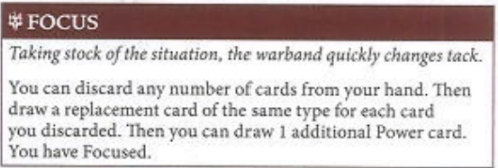
The new (and only) player core ability, Focus allows combines the prior versions of Venture and Strategize into a single Action step, and then some. When you Focus, you may discard as many cards as you wish from both your objective and power hand, then replace them from the appropriate decks. On top of that, you may still draw an additional Power card. Note that you do not have to discard anything, if all you want is to just draw a Power card like you would on a Venture. Games Workshop has been very clear about not wanting people to feel like they have bricked hands and this is definitely going to make it difficult to feel that way. So often you get down to the end of the game and just barely miss out on that one Power card you needed, or that one objective you could have scored. Now, if you are at that point, odds are you can get there if you are so determined. While it obviously does not behoove you to just spam this ability into oblivion and ditch all of your cards, the ability to get to the right card, particularly a Power card, when you need it most is incredibly potent. While I do think this can simply be too effective of an Action step from a power level perspective, I think it is actually a nice way of merging what was once two actions into one. That said, I do think it could use some toning down in the future to lower the ceiling on it a bit, likely with a limitation to the number of cards you can cycle in this way.
Resolving Attacks and Critical Successes
We’ve quite a bit to cover here, as this is likely the biggest change in terms of the “on the tabletop” aspects of the game, so we’ll just walk our way through the combat sequence.
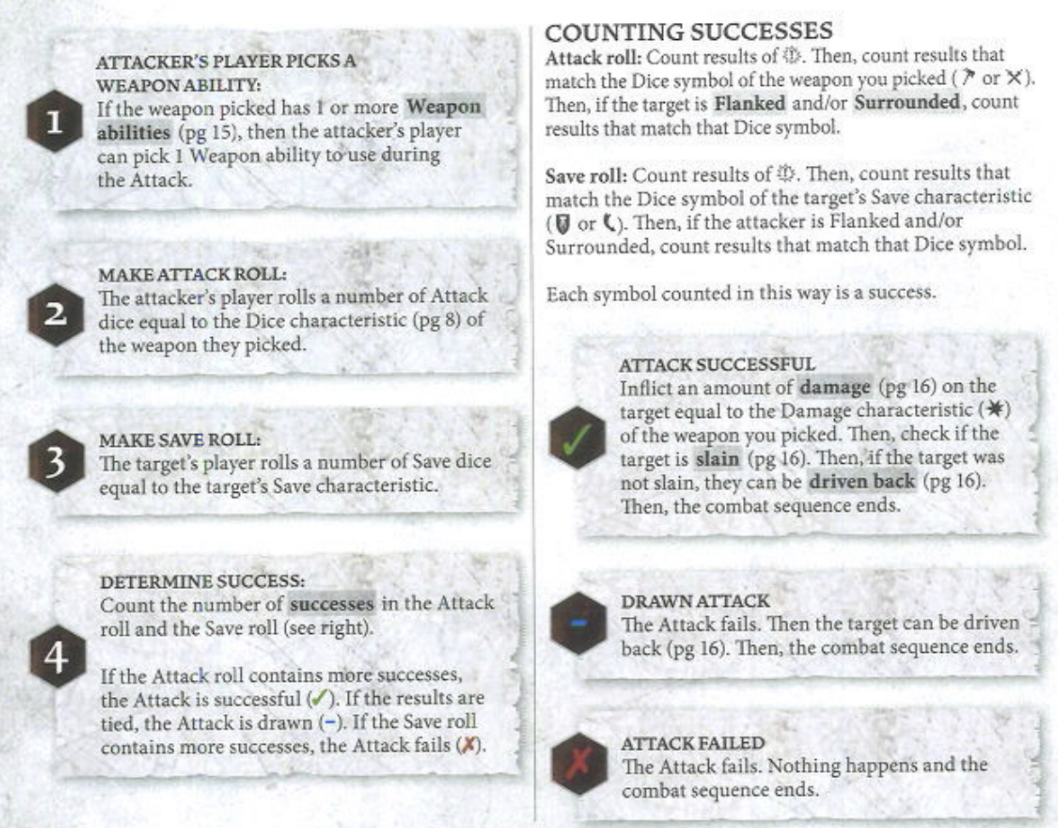
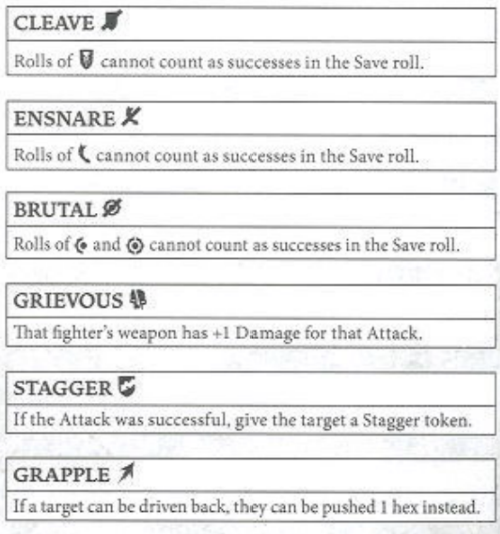
Right off the bat, you’ll notice we are picking a weapon ability, where only one can be used at a time, even if you have access to multiple. No longer will cleave+ensnare totally invalidate on-guard defence dice. You will also often have to choose between accuracy (cleave, ensnare, brutal) or damage (via grievous), so definitely a nerf to fighters trying to stack upgrades. Speaking of, grievous no longer stacks, and we’ve seen a number of updates sporting that ability rather than giving flat +Damage, meaning it will likely be a lot more difficult to one shot those big fighters than it once was. Speaking of weapon abilities, you’ll note that knockback and scything are no longer in the rulebook. It will be curious to see if they get added back in over time, but for now their removal is certainly a boon for guard and for hordes.
At the determine success step, we come to our next big shift, which is that you now simply count up your number of successes on each side, critical or otherwise. No more single-die crits blocking out a bunch regular successes! While Flaviuz has written a great summary of how this has affected attack odds, some highlights are that your basic 2H or 3S vs 1 defence die attacks are now slightly less accurate than they once were. Also, 3S (in a vacuum) now has generally lower accuracy than 2H, with hammers generally scaling much more favorably than swords.
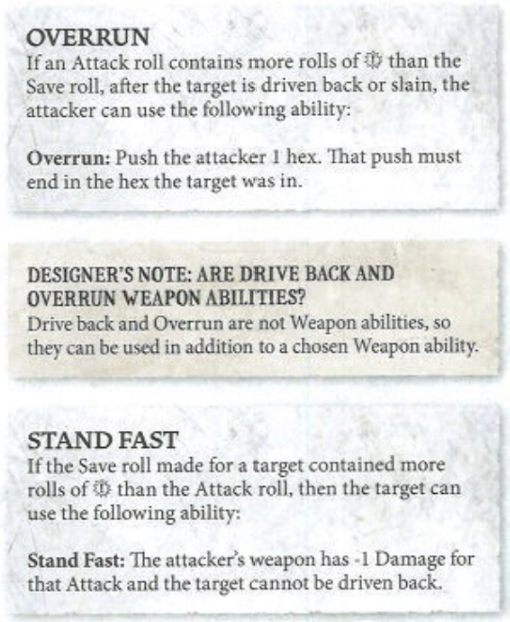
While crits will no longer swing the result of a dice roll quite as heavily, they will affect the resolution of the attack via the new “stand fast” and “overrun” abilities. For the first, if the save roll has more crits than the attack roll, the defender can “stand fast,” meaning they cannot be driven back and, if the attack was successful, reduce the damage taken by 1, to a minimum of 1. I have stressed this before, but, as cool as this ability is, it does not augment your overall bulk compared to the first edition, as meeting the condition to use it would previously have meant the attack just missed. What it can do is open up more possibilities to be hit by an attack while still surviving it, for the cases where that might be relevant (think things like first edition Gorechosen blood tithe acquisition). Overall, coupling this with the change to the determine success step I think is a huge win for the game and an excellent compromise on making crits impactful without them being quite as backbreaking in defence.
Meanwhile, if there are more crits in the attack roll than the save roll, the attacker can use the “overrun” ability to push themselves 1 hex into the hex the target was occupying. Note that this means you can only use it if you attack from adjacent, but it can set up some incredible positional opportunities, most notably when jumping onto feature tokens. This one, I am not quite as much of a fan. While I find it interesting, I think it has a good chance of reinserting some unwelcome crit volatility. If both myself and my opponent are fighting over a particular token or hex and one of us happens to knock the other off while getting to also overrun, but then the other comes up, knocks that fighter off and doesn’t get to overrun, that is going to feel bad. Maybe it won’t feel quite as bad as something like the single-die crit, but it is going to be a point of variance in the game which, from a competitive standpoint, is obviously not so desirable, even despite the fact it is a dice game in the first place.
Ability Resolution
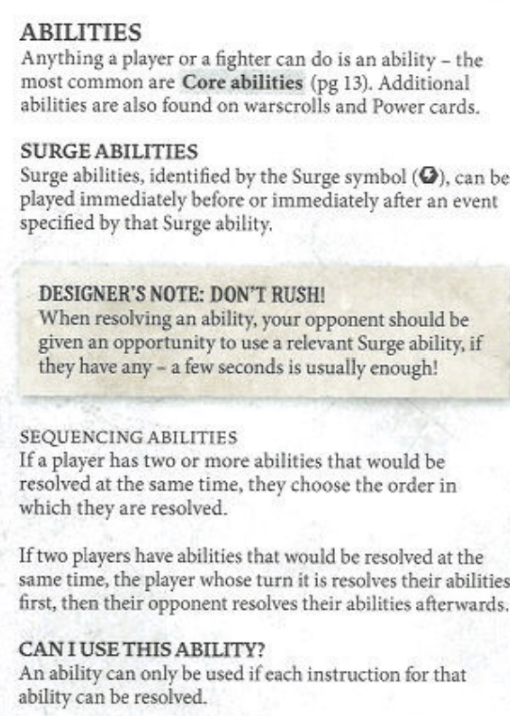
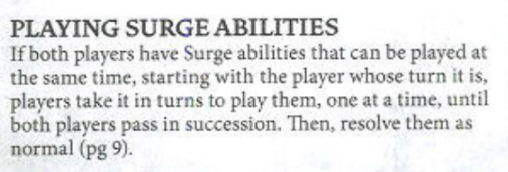
While this is nothing new, the rulebook still states that, if there are multiple simultaneous abilities to be resolved, you start with the active player and they may choose the order in which their abilities are resolved, then the other player resolves theirs in the same manner. However, what is new is that reactions are now referred to as surge abilities. While a simple name change is not particularly notable, the combination of this name change without the specific text in the rulebook about only using one surge ability per opportunity means that you’ll be able to apply the sequencing rules for simultaneous abilities to these surge abilities as well. Put more simply, you now get to resolve as many surge abilities as you wish for a single triggering event, rather than just one. This is one of those changes which, in a vacuum, is neither good nor bad, but will depend heavily on the kind of cards we see in the new design space. If we see a lot of cards with similar windows, we might see some potentially complex and highly potent sequencing of surge abilities. That’s not a bad thing, but it does mean that the designers will need to keep an eye out for exactly what kind of effects they are printing and watch out for potential combinations which might upset game balance.
Boards, Treasure Token Placement, and Deployment
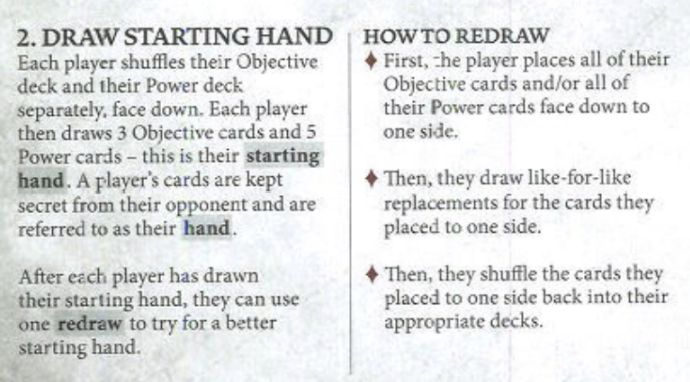
Another one with quite a bit to cover, but there has been a major overhaul of how the setup portion of the game operates. Quite notably, this starts with drawing your starting hand before the board and treasure tokens are set, meaning you can calibrate your decision-making during that process based on what you drew, which I actually kind of enjoy. Note also that you no longer show which cards you discarded on a redraw, which allows you to better conceal your strategy from your opponent.
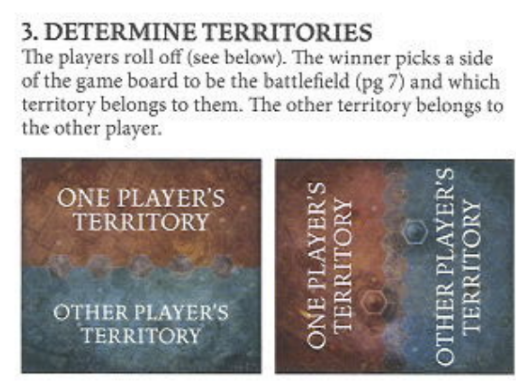
As for the boards, rather than each player choosing a game board to use, we now have just one board to share (double-sided). No more longboards, no more offsets, no more choosing from a stash of boards in your box, and even no more lethal hexes. After the initial roll-off, the winner decides which side of the game board will be used, as well as one of two orientations, and which of the two territories will belong to them.

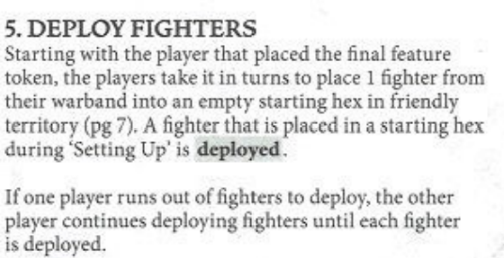
The player who lost the roll-off then places the first of 5 treasure tokens, but it must be in neutral territory. The players continue to alternate token placements until all 5 have been placed, with the same restrictions as previously except that each player’s territory must have at least one token. After that, the player who lost the roll-off begins deploying their fighters, with players alternating until all fighters have been deployed (notably, with no advantage granted on the roll-off to start the combat phase assigned to the player that finishes deploying first).
That was quite the exposition dump, but I felt it was important to fully summarize the rule before jumping in with my thoughts. While this undoubtedly reduces the complexity and potential skill expression during setup, I honestly think I am ok with that. The setup portion of the game was something I always skipped for new players because it was simply more complex than it needed to be when you just want to get to actually playing the game. I think I will personally appreciate the decreased setup time more than I will miss the strategy involved with it. That said, I do think we need some tweaking here. As it stands, the player who wins the roll-off may have actually increased their advantage compared to the first edition. Not only do they get the board and orientation they prefer, but they also get to place the first token with any real positional agency since the second player is obligated to place their first in neutral territory and may even get stuck making sure the “at least one token in each player’s territory” rule is satisfied. At minimum, if they really want to make sure at least one token is in each territory, just start with one token dead center in neutral territory and let the player who lost the roll-off place the next token without territorial restriction. I really hope this changes going forward, but for now there’s not much to do than hope you win the roll-off, which I guess we’d sort of already been doing. I just strongly feel like the roll is actually more important than ever, which seems odd amidst all the changes made in the name of improving balance.
Warscrolls
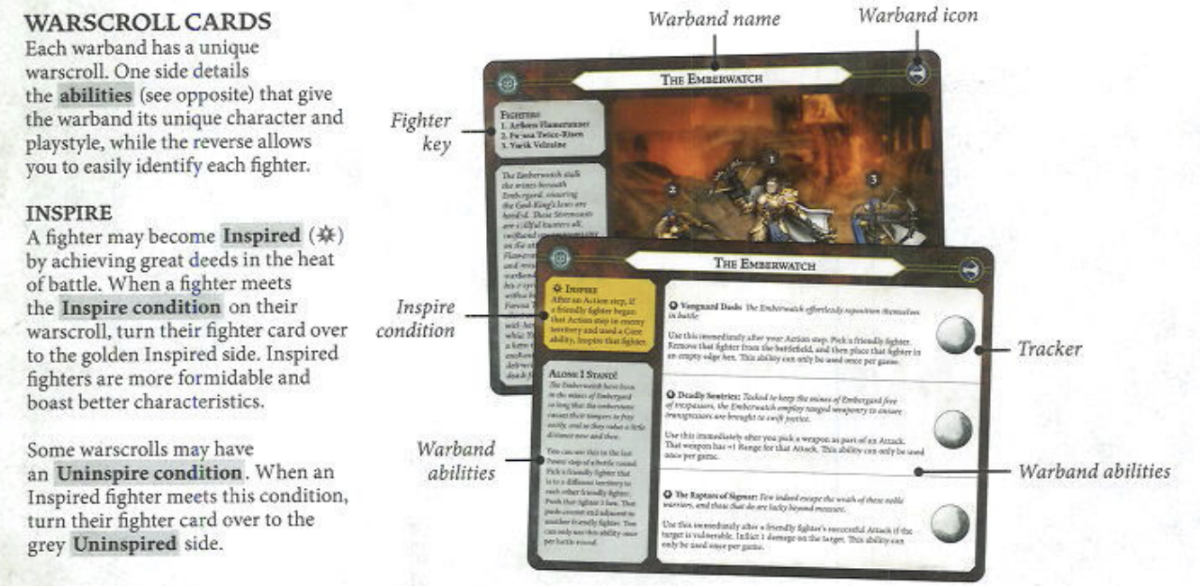
My personal number 1 most significant change to the game, this one is a doozy. For those who have been living under a rock, the decision was made heading into the second edition to use warscrolls instead of warband Rivals decks or on-card fighter abilities. This one is a huge mixed bag for me. On the not-so-positive side, this feels like another cost-saving measure (printing just one large card per warband instead of a 32-card deck). Additionally, I personally feel that it is borderline impossible to squeeze as many unique warband characteristics into a warscroll as were once on the fighter cards and in the Rivals decks. Furthermore, GW has stated that this will alleviate the unbalance caused by having faction Rivals decks, which is true in that there will no longer be unbalance warband Rivals decks (because those decks don’t exist), but also implies that all of the warscrolls will be equally balanced, which is obviously not going to be the case. As a competitive game, certain abilities will always be more valuable than others and it is unrealistic to expect that every single warscroll will be equally balanced from a power level standpoint and/or offer significantly impactful differences to distinguish one warband from another. I can appreciate that you won’t have as many “gotcha” moments from a unique card now that everything a warband can do is open information, but from an “accessibility” perspective, I can’t imagine a better way to get a new player going than saying “oh that’s the warband you’ve chosen, here’s a deck of cards specifically designed for only that warband to use” rather than now having to point them towards one of the universal Rivals decks.
On a more positive note, if they do plan to put out frequent and impactful balance updates, it should be a lot easier to update warscrolls than a whole 32-card deck. I fully expect a very unbalanced meta when the new edition drops, but hopefully this change will mean that balance can be enforced much more rapidly than what we’ve seen in years past. Continuing with the positives, the recent reveals for the Jaws of Itzl and Grandfather’s Gardeners have shown that the shift has not left them incapable of creating unique warbands either, as both of these warbands appear to have some very compelling mechanics, most notably the cycle mechanic on the Gardeners. Overall, this leaves me cautiously optimistic that we will see warbands with more flavor going forward than what is included in the core set, but it is still important to me that I feel I am playing with a warband rather than playing with whatever universal deck I chose/built. I don’t know that I’ll ever get to the point of viewing this change as being wholly for the better, but my initial take is that it won’t be strictly for the worse either.
Conclusions
Obviously, this is a much longer list than is typical for my rules update articles, but that’s to be expected with a brand new edition of the game. While I certainly do not agree with all of the decisions that were made (and, in some cases, even the justification given for said decisions), I think this largely marks an exciting new time for the game. While we’ve lost some opportunities for skill expression, there is a definite reduction in complexity to go along with that, which is not only helpful from a rules perspective, but also for getting new players into the game. While you obviously need to retain some of that complexity to keep the game engaging, I think it is undeniable that we were feeling pretty bloated at the end of the first edition in this respect.
That said, I do think that GW has undersold (or perhaps outright underestimated) the potential for lack of clarity with the reset, but I’m hopeful that we still get regular FAQ/Errata to address those confusing situations as we go along. Most emblematic of this to me is the marketing pitch that removing the sequence diagrams was a good thing. The game is still complex enough on surge abilities alone that we are going to need that back at some point and, to paraphrase Jonathan on our recent audio episode, simplicity is fine so long as it doesn’t come at the cost of clarity.
Still, I think this edition deserves to have me end this article on a positive note. It is clear that a lot of work went into designing the new edition, and I’m grateful to see that the game is going to continue to receive support for the foreseeable future. Despite the cases where I may disagree with how things were handled, this still looks and feels like Underworlds to me, even if I have to recalibrate how I think about the game, to a certain extent. I’m looking forward to doing what I can to help build up this community and to learning the game alongside you all.
Thanks so much for reading to this point and we wish you all the best of luck on YOUR Path to Glory!
